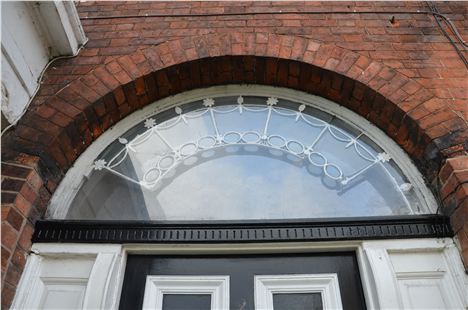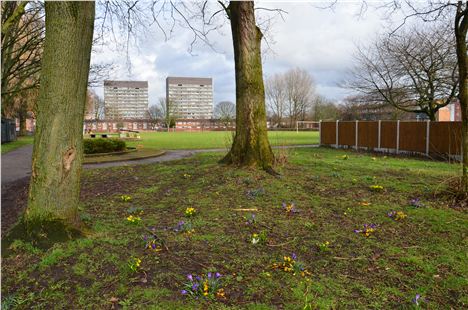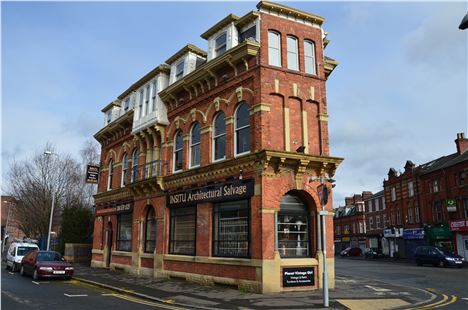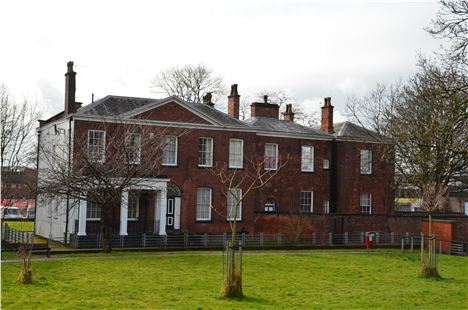Category: Average in terms of the buildings, priceless in terms of resonance.
What, who, how, where?
These are Pooley’s Houses, or the remaining north side of a pair that were the biggest in a posh group of residences in Hulme St Georges. You can find them on Princess Street, just off Chester Road where it turns into the big bypass to Old Trafford. They were built probably during the last years of the eighteenth century or the first of the nineteenth - if we could find out which princess the name of the road refers to we'd have out answer. Nobody knows the architect’s name. The owners were the Pooley’s, local landowners and mill owners. One early snippet we have of these folk is a brief mention in 1803 of the Hulme Volunteers and one Major Pooley who raised 190 local men to take on Bonaparte in the Napoleonic Wars.
 St George's Church in a fanciful early view with Hulme Hall in the background. Pooley's Houses lie to the left off the picture. Pooley's Houses have been converted to flats, so has the church, Hulme Hall in this picture, is waiting to be slaughtered by railways and canals.
St George's Church in a fanciful early view with Hulme Hall in the background. Pooley's Houses lie to the left off the picture. Pooley's Houses have been converted to flats, so has the church, Hulme Hall in this picture, is waiting to be slaughtered by railways and canals.
Gracious living
Well sort of. Anything with this type of typical Georgian pediment, portico, and big sash windows, has grace and balance. Round the back is a splendid bay window. This would have looked out across a gracious garden bordered on the west side by the clean and fresh Corn Brook (now spelt Cornbrook and famous as being an elevated and breezy Metrolink stop in the No Man's Land between city centre and the Old Trafford stadia). It would have a lovely spot, surrounded by other elegant residences. A couple of other charmers survive from the heyday namely an effortlessly sweet fanlight above the front door and a drinking fountain to the north of the front door. Whether anything original remains inside is hard to say, split into flats, nobody answered the door when Confidential came a-calling.
Lovely bay window window
 It's hard not to be a fan of this, damaged though it be
It's hard not to be a fan of this, damaged though it be
Here come the cavalry
Frequent guests at Pooley’s were the cavalry officers from the nearby barracks. In front of Pooley’s now is a pleasant park, this links to the football field to the east. The football field is one half of the site of Manchester’s cavalry barracks from 1817 to 1914 - for a while Pooley's Houses became part of the complex. The barracks variously housed the 15th Hussars, the 11th Hussars, the 2nd Heavy Dragoons (the Scots Greys) and so forth.
Map from 1849 showing Pooley's Houses bottom left and the cavalry barracks above
You can imagine Pride and Prejudice liasons taking place within the house. After all no ball was complete in Manchester without a few officers in uniform to make the ladies swoon. As for the barracks, stand under the goal posts closest to the house on the football pitch and you stand over the old ‘Ablution House’, close by were the stables, the forge, the straw store and cook houses. On each side would have been the barracks for the soldiers.
The field was one half of the exercise area for the horses. The area now occupied by handsome 1930s' flats was the other part, and contained a ball court and the ‘Magazine’. Bang. Balls in the big houses, canon balls here.
The flats aren't bad where horses used to practise manoeuvres
Charge into history
On 19th August 1819, the commander of the 15th Hussars was asked to make sure that the gathering at St Peter’s Fields didn’t get out of hand. The protesters wanted representation in Parliament, they wanted MPs for towns such as Manchester. It all went wrong when the local militia got involved, the 15th Hussars charged the crowd to disperse it before the militia slaughtered too many civilians. Fifteen people died on the day which became known as the Peterloo Massacre. The event so repelled public opinion that reform of Parliament became inevitable - even though it took a while to achieve.
Best dashing British officer name ever
The commander of the 15th Hussars was Lieutenant Colonel Guy l’Estrange. Perfect in every way for the name of a Regency cad and bounder. What do you think of the cut of his gib, madam, the fit of his breeches? There appears to be a Guy L'Estrange on Linkedn in Chester, there's another from Queensland who 'treks, paddles and climbs all over the planet'. Bet he's never led a full cavalry charge. I'm not sure I want to meet a contemporary Guy L'Estrange, they'd be a disappointment I'm sure. I'd not mind reading of one in a Sharpe novel though. 
Some Hussar officers from the time of Guy L'Estrange looking for some action
 Some women from the time of Guy L'Estrange waiting to attend a ball at Pooley's House - looks like those Hussars have good odds in grabbing a gal
Some women from the time of Guy L'Estrange waiting to attend a ball at Pooley's House - looks like those Hussars have good odds in grabbing a gal
Inspector of Scavengers
By the middle of the nineteenth century the bucolic, semi-rural loveliness was vanishing as the city expanded and industry grew along the nearby River Irwell. Working class terraces began to crowd around the barracks. A description in 1868 described the area as ‘dingy with marine stores, rag and bone shops and public houses of the lowest class’. The male population ‘consisted mainly of old soldiers’, the female population of ‘many soldiers’ wives whose husbands had married without leave’. One of the residents in 1849, was Alexander McKuthin, the Inspector of Scavengers.
One of the disreputable pubs, now In Situ antiques on Chester Road
So what does this all mean?
Buildings like this speak of a very different Manchester. As the town expanded in the early industrial period, these areas, a mile and a half from St Ann’s Square became upper middle class suburbs, in reach of town but by the side of the pretty Cornbrook stream. Pooley’s Houses were surrounded by elaborate gardens, and by a private park, Cornbrook Park – local householders had jobs such as ‘sharebroker', ‘engineer’, ‘auctioneer’, ‘merchant’, ‘attorney’. Now in the tough council suburb of St George’s these buildings are valuable as a reminder of a different past and, obliquely, of Peterloo. They’re the sort of structure which too often have been deliberately allowed to fade before being sneakily demolished. Places such as St George’s need them: they should be made the focus of the whole place, be a resource for the local schools, a prop for local pride. Let’s keep an eye on Pooley’s Houses shall we?
 The football field where once Guy L'Estrange messed around on a horse in his breeches
The football field where once Guy L'Estrange messed around on a horse in his breeches
 The loggia at the front, perhaps for morning chats on sunny summer mornings
The loggia at the front, perhaps for morning chats on sunny summer mornings
You can follow Jonathan Schofield on Twitter @JonathSchofield or connect via Google+





















